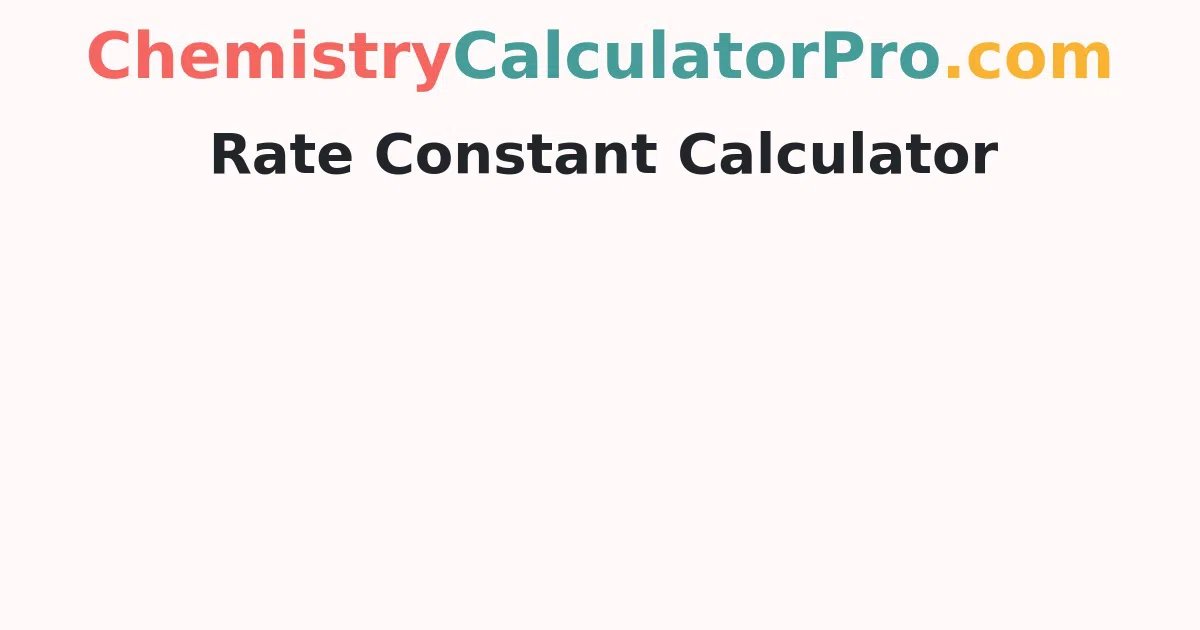Rate Constant Calculator
By using the rate constant calculator, we can calculate the rate of reaction, half life and rate constant easily. To get this values as output we need to give a inputs i.e order of the reaction, Reaction constant and concentration of the substances and then click the calculate button to avail the output.
Rate Constant, Half Life, Reaction Rate - Definitions
Rate Constant: It is the proportionality coefficient that depends on the temperature and the type of reaction.it can be described in many different equations
Half Life: The time required for half of something to undergo a process: such as. a : the time required for half of the atoms of a radioactive substance to become disintegrated.
Reaction Rate: The speed at which the chemical reaction proceeds. It is often expressed in terms of either the concentration (amount per unit volume) of a product that is formed in a unit of time or the concentration of a reactant that is consumed in a unit of time.
Rate Constant Formula
Based on the order of the reaction , the rate constant K have different formulas, given as follows
In zero order reaction
- Rate constant K = reaction rate
- Half life T1/2 = [A]/2K
For First Order Reaction
- Rate of reaction = k*[A]
- Half life T1/2 = (0.693) / K
- Reaction constant k = reaction rate / [A]
For second order reaction
- Reaction rate = K *[A]2
- Half life T1/2 = 1 / (k *[A])
- Reaction constant k = reaction rate / [A]2
Where, [A] is the concentration of the substance, K is the rate constant, T1/2 is the half life
Examples on Rate Constant
Question 1: Find the rate constant of a reaction of a substances. If the reaction rate is 2M/sec , concentration is 8M and the first order reaction is?
Given that,
Reaction rate is = 2M/sec
Concentration of the substances is [A] = 8M
Formula for first order reaction,
Rate constant (or) reaction constant K = reaction rate/[A]
K = 2/8 = 0.25 / sec
Half life T1/2 = (0.693) / K
= 0.693 / 0.25 = 2.772 sec
The rate constant k is 0.25 /sec and half life is 2.772 sec.
Question 2: Find the rate constant of a reaction of a substances. If the reaction rate is 4M/sec, concentration is 10M and the zero, first, second order reaction is?
Given that,
Reaction rate = 4M/sec
Concentration of the substances is [A] = 10M
Formula for zero order reaction,
Rate constant k = reaction rate k = 4/sec
Half life T1/2 = [A]/2K = 10 / 2*4 = 10/8 = 1.25 sec
Formula for first order reaction,
Rate constant (or) reaction constant K = reaction rate/[A]
K = 4/10 = 0.4/sec
Half life T1/2 = (0.693) / K = 0.693/0.4 = 1.7325 sec
Formula for second order reaction,
Reaction constant k = reaction rate / [A]2
= 4/10*10 = 4/100 = 0.04 /sec
Half life T1/2 = 1 / (k *[A]) = 1 / 0.04 *10 1/0.4 = 2.5 sec
FAQs on Rate Constant
1. What is the Rate Constant?
The rate constant is defined as the proportionality constant in the equation that expresses the relationship between the rate of a chemical reaction and the concentration of the reacting substances. It is known as the reaction rate constant and it is dependent on temperature.
2. What are the units of rate constant?
The units of the rate constant depend on the overall reaction order.
- The units of rate constant K for zero- order reaction are M/s
- The units of rate constant K for first- order reaction are 1/s
- The units of rate constant K for second - order reaction are 1/ (M.s)
3. What is the difference between rate constant and rate of reaction?
The rate constant is proportionality constant for a given reaction. The reaction rate is expressed in terms of consumption of reactants or product formation per unit time. The units for rate of reaction is mol/lit cm
4. How does the rate constant change with temperature?
The rate constant goes on increasing as the temperature goes up, but the rate of increase falls off quite rapidly at higher temperatures. A catalyst will provide a route for the reaction with a lower activation energy.
5. Is the rate constant (k) always less than 1?
No, the rate constant k can’t be always less than 1. It can be equal to 1 at times neither favoring the reactants nor products.
